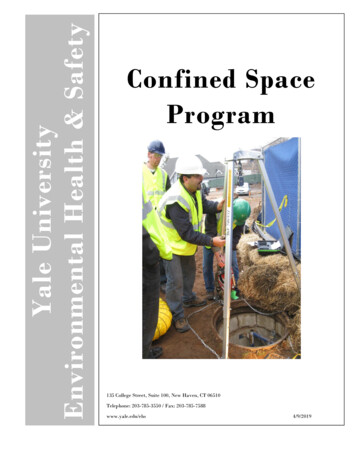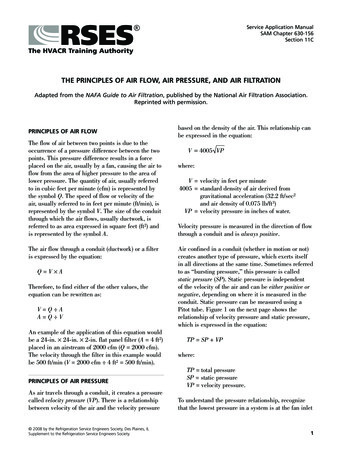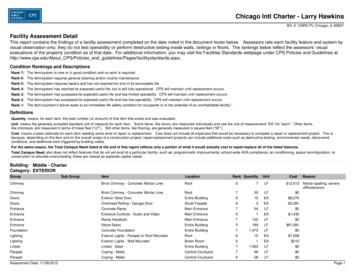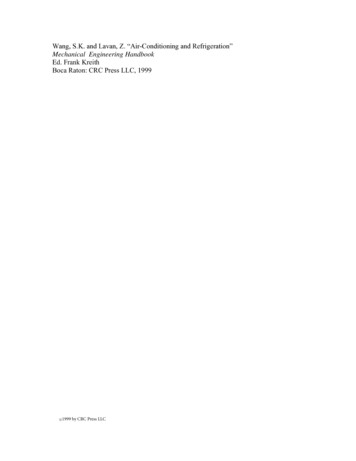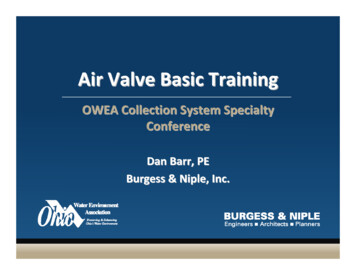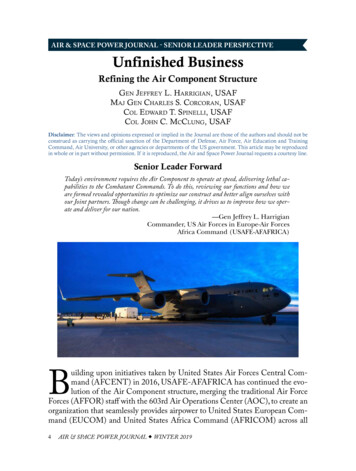
Transcription
AIR & SPACE POWER JOURNAL - SENIOR LEADER PERSPECTIVEUnfinished BusinessRefining the Air Component StructureGen Jeffrey L. Harrigian, USAFMaj Gen Charles S. Corcoran, USAFCol Edward T. Spinelli, USAFCol John C. McClung, USAFDisclaimer: The views and opinions expressed or implied in the Journal are those of the authors and should not beconstrued as carrying the official sanction of the Department of Defense, Air Force, Air Education and TrainingCommand, Air University, or other agencies or departments of the US government. This article may be reproducedin whole or in part without permission. If it is reproduced, the Air and Space Power Journal requests a courtesy line.Senior Leader ForwardToday’s environment requires the Air Component to operate at speed, delivering lethal capabilities to the Combatant Commands. To do this, reviewing our functions and how weare formed revealed opportunities to optimize our construct and better align ourselves withour Joint partners. Though change can be challenging, it drives us to improve how we operate and deliver for our nation.—Gen Jeffrey L. HarrigianCommander, US Air Forces in Europe- Air ForcesAfrica Command (USAFE- AFAFRICA)Building upon initiatives taken by United States Air Forces Central Command (AFCENT) in 2016, USAFE- AFAFRICA has continued the evolution of the Air Component structure, merging the traditional Air ForceForces (AFFOR) staff with the 603rd Air Operations Center (AOC), to create anorganization that seamlessly provides airpower to United States European Command (EUCOM) and United States Africa Command (AFRICOM) across all4 AIR & SPACE POWER JOURNAL WINTER 2019
Unfinished Businessphases of joint operations. The realignment’s foundation is the Strategy- Planning- Execution- Assessment process developed in the USAFE- AFAFRICA five- yearAir Component Support Plan (ACSP) “playbook.” Armed with the ACSP, theoptimized USAFE- AFAFRICA Air Component is well- postured to provide air,space, and cyber power to the joint and coalition team across both areas of responsibility (AOR).The ProblemTo support the long war, the primary focus of USAFE- AFAFRICA’s AFFORstaff became the preparation of assigned forces for deployments supporting theglobal violent extremist organizations fight. Meanwhile, the 603rd AOC, alignedunder the 3rd Air Force, was almost wholly focused on preparations for full- scalearmed conflict in the EUCOM AOR.1 The resurgence of Russia and the releaseof the 2018 National Defense Strategy (NDS) exposed a significant gap in thisconstruct. Specifically, there was little focus on operations, activities, and investments in the air domain required to assure our allies and deter potential adversaries across the EUCOM AOR. The command needed an overhaul to ensure thatall assigned resources (AFFOR and the 603rd AOC) had the necessary andproper focus on “Phase 0” and “Phase I” activities to support competition short ofconflict with the appropriate speed and stance. Step one was the placement of the603rd AOC directly under Air, Space, and Information Operations (A3), removing the deliberate separation between the AFFOR staff and the AOC while alsoaligning the organization with the Napoleonic Unified Command structure. Steptwo was the optimization of the combined organization, merging redundant andduplicative functions. The result is a single voice from the wing- level forcesthrough the Air Component to the combatant command with the ability to strategize, plan, execute, and assess across the entire spectrum of conflict with speed.Strategy to Execution to AssessmentThe 2018 NDS identified the ability to conduct multidomain operations at thespeed of relevance as a key to success in great- power competition.2 From the AirComponent perspective, the ability to conduct multidomain operations at thespeed of relevance requires an organizational structure that facilitates a clear line- of- effort (LOE) from the joint force air component commander’s ( JFACC) strategic intent to the execution of day- to- day operations. Historically, the USAFE- AFAFRICA Plans, Programs, and Analyses Directorate (A589) focused ondeliberate operational planning and strategy development for Phase II theatercontingency plans. Simultaneously, the Operations, Strategic Deterrence, andNuclear Integration Directorate (A3/10) focused on current operations andAIR & SPACE POWER JOURNAL WINTER 2019 5
Harrigian, Corcoran, Spinelli, & McClungmonitoring the preparation of assigned units for the entire spectrum of conflictwhile maintaining a secondary focus on operational planning and the execution ofconventional deterrence in the USEUCOM AOR.3 Meanwhile, an additionalentity—the 603rd AOC—executed a doctrinally- driven, overlapping current operations role. As such, A589 plans and A3/10 and 603rd AOC operations werenot synchronized to ensure effective execution, which resulted in the decouplingof the strategy- to- task model, redundant and duplicative execution, and difficultyin assessing actual effects.To ensure a clear strategy to task line- of- guidance exists, USAFE- AFAFRICAcreated an ACSP, implementing a methodical planning and assessment framework into the battle rhythm. This framework allows USAFE- AFAFRICA to assess activities against the combatant commanders’ desired end states, ensuringoperational objectives are aligned with the combatant command’s strategic LOEs.The ACSP describes how the Air Component will synchronize operations,activities, and investments across the entire spectrum of conflict, which, in turn,ensures holistically planned, executed, and analyzed assurance and deterrence activities. It is informed by both EUCOM and AFRICOM theater campaign objectives and combatant command plans. Most importantly, through its measuresof effectiveness, the ACSP provides a tangible road map to gauge achievement ofoperational objectives.Tying it all TogetherThis Air Component Support Plan is USAFE- AFAFRICA’s “playbook” for the next 5years. It is our guide to synchronizing operations, activities, and investments vital to thesuccess of USEUCOM and USAFRICOM theater campaigns.General HarrigianU- A Air Component Support Plan 2019The ACSP seamlessly integrates strategic and operational assessment anddrives the Air Component’s Strategy- Planning- Execution- Assessment battlerhythm as depicted in figure 1.Strategy to Planning to Execution to AssessmentFuture PlansACSupportPlanExercises(How/Who)Future Ops(Why/How) Syncs JFACCguidance via JOPP CAP & Future OpsDevelopment leadAODCTGCurrent Plans(What/When) Builds MDO Plans Produces all OrdersATOOrdersOT&E(Who/How)Assessment and EnablersFigure 1. Organizational Strategy- Planning- Execution- Assessment6 AIR & SPACE POWER JOURNAL WINTER 2019Current Ops(Execute) C2/Execution Component Ops Ctr
Unfinished BusinessWithin the A3/10, the Future Operations (A35) Division provides “the why”and “the how” to the rest of the Air Component. Additionally, Future Operationsintegrates with the Organize, Train, and Equip (OT&E) and Exercises Divisionsto determine “who” is being directed. Future Operations also provides direction tothe Current Plans (A36) Division via a myriad of products, such as the Air Operations Directive, which initiates the air tasking cycle and the creation of CommandTraining Guidance (CTG).4 Next, Current Plans builds the plans and orders assigned forces to execute by providing “the what” and “the when.” Finally, the Current Operations (A33) division commands and controls assigned forces and executes. Integrated throughout the entire process are force enablers, such as an AirMobility (A34) and a Nonkinetic/Special Activities Operations (A39) division.Finally, Future Operations codifies operational- level assessments, which, inturn, aids in producing updated air operations directives and CTG. Next, theAssessment Directorate (A9) leads the strategic assessment process for USAFE- AFAFRICA by measuring the command’s effectiveness at achieving its operational objectives. These assessments are used to identify capability gaps and recommend adjustments to resourcing command priorities, weight- of- effort, or5plans, including future ACSPs.Refined FrameworkPast doctrinal distinctions between Air Force forces (AFFOR) and the AOC placed the AirComponent at a disadvantage, or worst- case exclusion, when addressing COCOM andcross- component operational issues. Additionally, the distinct differences and separation ofthe AFFOR and AOC staffs previously articulated in Air Force doctrine and instructionshave created confusion and dysfunction for operational elements both inside and outside theAir Component.Lt Gen CQ Brown Jr. and Lt Col Rick Fournier“No Longer the Outlier: Updating the Air Component Structure”Air & Space Power Journal 30, no. 1“No Longer the Outlier”The USAFE- AFAFRICA A3/10 Directorate’s optimized organizationalstructure was derived from AFCENT’s framework and was heavily influenced byGeneral Brown and Lieutenant Colonel Fournier’s article, “No Longer the Outlier: Updating the Air Component Structure.” USAFE- AFAFRICA removedthe deliberate separation between the AFFOR staff and the AOC, aligning theorganization with the Napoleonic Unified Command structure. The result is asingle voice from the Air Component to the combatant command with the abilityto strategize, plan, execute, and assess across the entire spectrum of conflict.AIR & SPACE POWER JOURNAL WINTER 2019 7
Harrigian, Corcoran, Spinelli, & McClungUSAFE- AFAFRICA designed its Air Component structure based on thestrategy, planning, execution, and assessment process described in the ACSP, asopposed to the traditional AOC/air tasking order (ATO) timeline paradigm. Therevised structure flattens the organization by directly connecting the staff to thetactical point of execution, removing functional stovepipes, increasing transparency, and accelerating the speed of decision making. (see figure 2)JFACCCOMAFFORA5/8/9A5XFuture PlansA8XStrat & PlansA3/10A9AAssessementsA1, A2, A4, A6DC4DS4A3DA3DAOCDirectorAOC/CCA30OT & EA37ExercisesA10NNuke OpsA32ISR OpsA33/38Current OpsA34MobilityA35Fu OpsA36Current PlansISRDCODAMDSRDCPDA39NKO & SAIAMDFigure 2. Evolved air component structureNotes: The joint force air component commander (JFACC) has the discretion to assign any flag officer as the AOC director. During Phase 0/I operations, the A3/10 is the AOC director but has delegated the day- to- day operations down to the AOC commander.The director of mobility forces is dual- hatted as the A34, DC4, and DS4 work directly for the JFACCand maintain a support relationship with the AOC.Key: COMAFFOR: commander, Air Force Forces; A1: manpower, personnel and services; A2: intelligence, surveillance, and reconnaissance; A4:logistics; A5/8/9: plans programs and analyses; A6: communication; DC4: director of cyber forces: DS4: director of space forces; A3D: operationsdeputy; Fu Ops: future operations division; NKO and SA: nonkinetic operations and special activities; ISRD: intelligence, surveillance, and reconnaissance Division; COD: Combat Operations Division; IAMD: Integrated Air and Missile Defense; AMD: Air Mobility Division; SRD: Strategy Division; andCPD: Combat Plans Division. The A5X (Future Plans) develops the commander, USAFE- AFAFRICA(COMUSAFE‐AFAFRICA) contingency and steady state plans by leading theAir Component through the joint planning process. In coordination with otherdirectorates, the A5X develops the Air Component’s operational approach andcommander’s intent, then relays it to the rest of the Air Component via the ACSP. The AOC commander is responsible for all traditional A3 COMAFFOR divisions and the traditional AOC roles, granting them the authority and responsibilityto manage all phases of the A3 Strategy- Planning- Execution- Assessment process. The A35 (Future Operations) operationalizes ACSP guidance by providinglinkages to the embedded objectives via an operational annex. This annex informsthe Air Component by integrating/prioritizing multidomain operations and ex8 AIR & SPACE POWER JOURNAL WINTER 2019
Unfinished Businessercises. Using the ACSP annexes, the A35, in conjunction with the A30 (OT&E)and A37 (Exercises), produces the AOD and CTG. The USAFE- AFAFRICA A35 differs from the AFCENT model, as it includes the AOC’s SRD. In AFCENT, the A35 is centered on the AOC’s CPD.USAFE- AFAFRICA diverged from AFCENT’s methodology because of thelong timeline and inherent strategic nature of assurance and deterrence activities.This new concept falls outside the doctrinal 96-hour time horizon for the SRD,forcing a closer collaboration between the A35 and A5.6 To facilitate this change,the traditional AFFOR Operations and Plans division and Global Force Management branch were integrated into the A35. The A36 builds detailed multidomain operations plans, informed by the guidance produced by the A35.7 The A36 converts plans into tasks and assigns themvia the ATO, planning documents, and orders. The A36 includes the AOC’s CPD and is guided by the A35 products. In thisoptimized construct, the A36 must look beyond the doctrinal 72-hour ATO cycle.8To assist with this task, the A36 incorporated the AFFOR staff Current Operations branch. The A33/38 (Current Operations/IAMD) oversees execution of all EUCOMand AFRICOM air component operations and provides a single point of entryfor higher headquarters and fielded units. The A33/38 is also the focal point forexecution of IAMD and advises COMUSAFE‐AFAFRICA in his/her role asthe area air defense commander. The A-32 and A-34’s roles as the Air Mobility Division and Intelligence,Surveillance, and Reconnaissance Division have not changed. Nonkinetic/Special Activities Operations provides operational- level command and control of space, electronic warfare, cyber, and information warfareoperations. The A39 is matrixed across the Air Component. This ensures multidomain effects are integrated throughout the Strat- Task battle rhythm while maintaining a single chain of command. Strategic deterrence and nuclear integration (A10N) remains the focal pointfor nuclear operations, providing policy, guidance, and oversight for nuclear operations and command and control.ConclusionUSAFE- AFAFRICA’s optimized Air Component structure improves thecommand’s ability to support joint and coalition partners in the AFRICOM andEUCOM AORs across the spectrum of competition to conflict, but the evolutionis not complete. Further analysis on the proper integration of intelligence, logistics, and nonkinetic operations, both within the A3/10 directorate and across theAIR & SPACE POWER JOURNAL WINTER 2019 9
Harrigian, Corcoran, Spinelli, & McClunglarger Air Component staff, must be accomplished. Additionally, we continue toreview the role of the numbered Air Force in this optimized structure. Regardlessof future evolution, the current realignment is producing positive results, providing four- star Air Component leadership with timely decision quality information,ensuring lethal airpower in the EUCOM and AFRICOM AORs. Gen Jeffrey L. Harrigian, USAFGeneral Harrigian (MA, Marshall Center; BS, United States Air Force Academy) is the commander of US AirForces in Europe- US Air Forces Africa (USAFE- AFAFRICA), and Allied Air Command; and director of Joint AirPower Competence Centre. He is responsible for the air and missile defense of 29 North Atlantic Treaty Organization alliance member nations and commands US airpower across more than 19 million square miles.Maj Gen Charles S. Corcoran, USAFMajor General Corcoran (MA, National Defense University; BS, United States Air Force Academy) is the commander, US Air Force Warfare Center, Nellis AFB, Nevada. He oversees more than 14,000 military and civilianpersonnel serving in the 57th Wing, 53rd Wing, 99th Air Base Wing, 505th Command and Control Wing, the Nevada Test and Training Range, and the Air Force Joint Test Program Office.Col Edward T. Spinelli, USAFColonel Spinelli (MBA, New York Institute of Technology; BS, Rochester Institute of Technology) is the DeputyDirector of Operations, Strategic Deterrence and Nuclear Integration, for US Air Forces in Europe-Air Forces Africa.Col John C. McClung, USAFColonel McClung (MBA, Toro University; MA, Air University; MA, National Intelligence University; BS, NorthCarolina State University) is the chief of the Combat Operations and Integrated Air Missile Defense Divisions,603rd Air Operations Center, Ramstein AB, Germany.Notes1. Curtis E. LeMay Center for Doctrine Development and Education, “Appendix C: The AirForce Forces Staff,” in Annex 3-30, Command and Control, 7 November 2014, 41, https://www.doctrine.af.mil/.2. DOD, National Defense Strategy (Arlington, VA: Pentagon, 2018), 7, https://dod.defense.gov/.3. U- A Instruction 10-1, Concept of Operations for HQ USAFE- AFAFRICA, 47, para. 5.1.4. AFI 13-1AOC, vol. 3, Operational Procedures—Air Operations Center (AOC), 22, para. 3.1,https://static.e- publishing.af.mil/.5. U- A Air Component Support Plan 2019, ii.6. AFI 13-1AOC, vol. 3, Operational Procedures, 22, para. 3.1.7. AFI 13-1AOC, vol. 3, Operational Procedures, 26.8. AFI 13-1AOC, vol. 3, Operational Procedures, 29.10 AIR & SPACE POWER JOURNAL WINTER 2019
4 AIR & SPACE POWER JOURNAL WINTER 2019 AIR & SPACE POWER JOURNAL ff SENIOR LEADER PERSPECTIVE Unfinished Business Refining the Air Component Structure Gen Jeffrey L. HarriGian, USaf MaJ Gen CHarLeS S. CorCoran, USaf CoL edward T. SpineLLi, USaf CoL JoHn C. MCCLUnG, USaf Disclaimer: The views and opinions expressed or implied in the Journal are those of the authors and should not be



